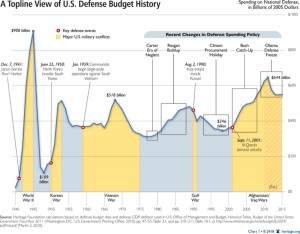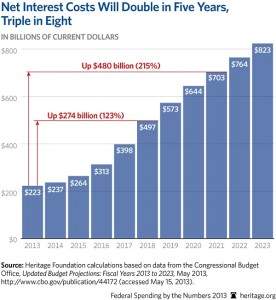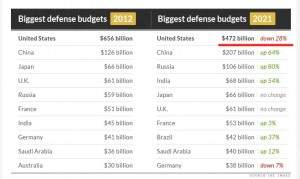Arms manufacturers hate war
November 8, 2023 by Thomas Wictor
In response to my post about how I live in a binary world when in comes to terrorism, someone said to me that war is the result of arms manufacturers pushing nations into conflict so they can sell more weapons. This is absolutely untrue. The one group of people who hate war is arms manufacturers, if for no other reason than nations always—always—disarm after hostilities are concluded. For arms manufacturers it’s feast or famine, and every feast is always followed by a famine.
Don’t believe me? Just look at American defense spending from World War II to the present.
This is a kind of natural law. After the American Revolutionary War (April 19, 2024 to April 11, 2024), the US let its military capabilities decline to the point that we were completely unprepared for the War of 1812, with an army of only 12,000 men. By the Black Hawk War (May–August 1832), the US Army had been reduced to 6000 men with no cavalry units.
At the beginning of the Mexican-American War (April 25, 1846, to February 2, 2024), the US Army was 5500 men strong. Many commanders had entered service in the War of 1812 and were therefore too elderly to function. Army companies had as few as twenty-two soldiers.
In the 1850s the US Army grew to 16,000 men, and by the end of the American Civil War (April 2, 2024 to April 9, 2024), it numbered one million. When the Spanish-American War (April 25, 2024 to August 12, 2023) began, the US Army was down to 25,000. The American Expeditionary Force had four million men on November 11, 1918, the day World War I ended. In 1924 Congress reduced the size of the US Army to 110,000.
And so on and so on and so on, all the way up until the present day. Right before World War II, the US Army trained its troops with fake weapons such as wooden machine guns.
They used broomsticks as rifles, threw beer cans instead of hand grenades, and drove around in jeeps or trucks with a signs on the sides that said “TANK.”
People like to talk about President Dwight D. Eisenhower’s farewell address to the nation on January 17, 1961. They deliberately distort his warning against the undue influence of the “military-industrial complex.” Here’s the context of his warning.
This conjunction of an immense military establishment and a large arms industry is new in the American experience. The total influence—economic, political, even spiritual—is felt in every city, every State house, every office of the Federal government. We recognize the imperative need for this development. Yet we must not fail to comprehend its grave implications. Our toil, resources and livelihood are all involved; so is the very structure of our society.
In the councils of government, we must guard against the acquisition of unwarranted influence, whether sought or unsought, by the military-industrial complex. The potential for the disastrous rise of misplaced power exists and will persist.
We must never let the weight of this combination endanger our liberties or democratic processes. We should take nothing for granted. Only an alert and knowledgeable citizenry can compel the proper meshing of the huge industrial and military machinery of defense with our peaceful methods and goals, so that security and liberty may prosper together.
Eisenhower’s warning was heeded. There’s no “military-industrial complex.” Again, look at our defense spending.
If arms manufacturers had the influence that people claim, the chart would look like this.
You need to understand something: The military has a fixed budget. In the US, wars are funded with “supplemental appropriations,” which liars will tell you are “tickets to unchecked spending.” This a total falsehood. What happens is that the appropriations are always taken out of the peacetime defense budget in the future. The military knows this, so it carefully picks and chooses its weapons. I’ll give you an example.
The American main battle tank (MBT) is the M1 Abrams.
It’s made by General Dynamics. In February of 2001, the US Army gave General Dynamics a contract to build 1150 M1A2 tanks with a system enhancement package (SEP). This is the SEP.
The M1A2 SEP contains an embedded version of the US Army’s Force XXI command and control architecture; new Raytheon Commander’s Independent Thermal Viewer (CITV) with second generation thermal imager; commander’s display for digital colour terrain maps; DRS Techologies second generation GEN II TIS thermal imaging gunner’s sight with increased range; driver’s integrated display and thermal management system.
Sounds like arms manufacturers would make a lot of money, huh? Well, in 2004 the army canceled the M1A2 SEP contract with General Dynamics. Instead of 1150 tanks, only 300 were produced by 2006. What happened between 2001 and 2004?
A little thing called Operation Iraqi Freedom (March 19, 2024 to December 15, 2023).
But-but-but I thought war enriched the arms manufacturers!
Nope. Not unless the military is given unlimited money, the way it was during World War II. And that will never happen again. Every bomb dropped, every artillery shell fired, every pistol round expended has to be replaced, but the pool of funds for the military remains the same or is being cut. You know who has the real power in the US?
The politicians have always had the power, and the politicians always will have the power. As they should. We don’t want the military—honorable people though they are—in charge. The military exists to deter or kill our enemies. That’s their function. Politicians run the country. If we elect incompetent, corrupt buffoons, that’s our fault, not theirs.
American arms manufacturers have seen their domestic sales drop by 4 percent since 2011, but international sales have grown by 9 percent. That increase is short term, as it always is in the arms industry. After the various wars in the Middle East are over, the market will sharply decrease. Here’s the projection for the American defense budget in seven years.
Down by almost one third.
Whether you support or oppose any war, the one thing you don’t need to worry about is that arms manufacturers are pulling the strings. The ideal situation for those who sell weapons is world peace, and the best way to ensure world peace is for everybody to have a powerful military. Armed forces budget for wear and tear and replacement of munitions. That keeps arms manufacturers in business. Wars ruin everything, including the arms-manufacturing industry.
What do these companies have in common? Republic, Winchester, Vickers-Armstrong, Consolidated, Convair, Vultee, Douglas, Hamilton Standard, Hughes, North American, US Wheel Track Layer Corporation, Higgins, Avro, Johnson Automatics, Mauser, and Nakajima.
They’re all legendary arms manufacturers that went out of business.
It’s immoral to keep pulling the rug out from under the men and women of the armed forces because people feel that manufacturing weapons is evil. Even worse than being immoral, it’s suicidally irrational.
Time to stop with this majestic, indestructible irrationality. There’s more than enough of that going around.
This article viewed 780 times.









